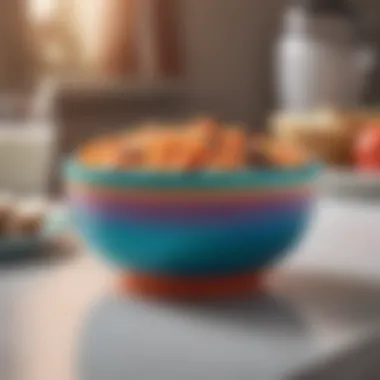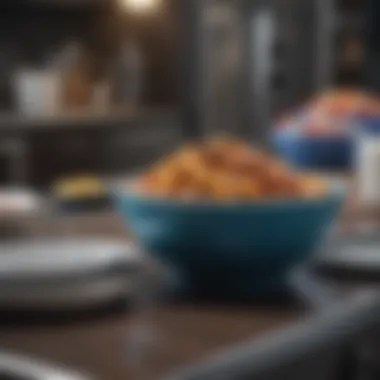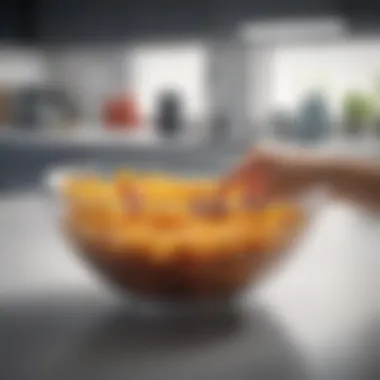Versatile Plastic Bowl Covers: A Practical Guide


Intro
In our ever-changing kitchen landscape, plastic bowl covers with elastic stand out as a practical yet often overlooked solution. They are not merely covers; they serve various purposes, blending convenience with style. Whether you are a busy professional or a home cook, these elasticized covers can make a world of difference.
Their importance lies in their functionality—adding a layer of protection for your food, and ensuring freshness while also reducing waste. As environmental concerns grow, many homeowners are leaning towards eco-friendly options, making it crucial to understand the diverse materials used in these covers. The process of storing food efficiently is intertwined with design, aesthetics, and practice in a kitchen.
This article aims to explore these facets comprehensively, offering insights that cater to designers, retailers, and everyday culinary enthusiasts alike. From the various types of plastic bowl covers available to their impact on the overall kitchen environment, this guide delves deep into the versatility of these products, unveiling how they can seamlessly integrate into any kitchen design.
The Concept of Plastic Bowl Covers with Elastic
When it comes to modern kitchen essentials, plastic bowl covers with elastic have become increasingly important. They stand out due to their unique combination of flexibility, convenience, and effectiveness in food preservation. In a world where sustainability and efficiency are paramount, understanding the key benefits and considerations surrounding these covers is essential for any homeowner, designer, or culinary enthusiast.
Let’s dive into the concept, starting from what actually defines plastic bowl covers, followed by an exploration of how the elastic potential truly enhances their functionality.
Defining Plastic Bowl Covers
Plastic bowl covers are a simple yet powerful solution for food storage. They are usually made from food-safe plastic and are designed to fit over various bowl sizes. What sets them apart is the elastic band that ensures a snug fit, preventing spills and extending the life of the contents inside. Unlike traditional lids that can be cumbersome and rigid, these covers offer a flexible alternative that adapts to different bowls. This makes them a versatile choice for all kinds of kitchenware — from mixing bowls to casserole dishes.
They come in various sizes and styles, allowing users to select an option that fits their specific needs. For example, a large stretchy cover can easily accommodate a hefty salad bowl, while smaller versions are perfect for leftover soup in a mug. This flexibility not only keeps food fresh but also enhances the overall kitchen aesthetic.
Understanding Elastic Mechanisms
Elastic mechanisms are at the heart of what makes these bowl covers so effective. The embedded elastic creates a kind of dynamic tension, enabling the cover to stretch and conform to the shape of whatever bowl it is placed over. Here’s how it works:
- Snug Fit: The elastic ensures that the cover stays in place even when jostled around in a fridge or stacked atop other containers.
- Sealed Environment: A snug fit also helps to create a sealed environment. This is vital for keeping food fresh and preventing unwanted aromas from pervading your other dishes.
- Adaptability: The elastic nature allows for a form of adaptability. When you put a cover over a bowl, it accommodates slight variations in size, which is particularly advantageous for those of us who have a hodgepodge of dishware.
"Plastic bowl covers with elastic are not just covers; they are a game changer for efficient food storage and presentation in modern kitchens."
The fact that they are easy to stretch over bowls of various shapes adds a layer of convenience that traditional lids simply cannot provide. It’s the freedom to quickly cover dishes without the hassle of mismatched lids that makes these bowl covers not just practical but almost indispensable in contemporary kitchens.
In sum, the concept of plastic bowl covers with elastic brings together essential elements of functionality, convenience, and style. This combination underscores their relevance in today’s culinary landscape, making them an invaluable tool for anyone looking to enhance their kitchen experience.
Material Composition and Properties
When considering plastic bowl covers with elastic, understanding their material composition and properties is key to recognizing their role in modern kitchens. The right materials ensure functionality, durability, and user satisfaction. Let’s unpack this important aspect of bowl covers, shedding light on the specifics that can influence your purchasing decisions.
Types of Plastics Used
The world of plastics is extensive, and not all plastics are created equal. In the case of elasticized bowl covers, several types of plastics are commonly utilized:
- Polyethylene (PE): This plastic is lightweight, flexible, and provides basic protection against moisture. Its flexibility makes it an ideal choice for elastic covers since it can easily stretch over different bowl sizes without tearing.
- Polypropylene (PP): Known for its strength and resistance to heat, polypropylene is a popular choice for those looking for more durable covers. It holds up well under various temperatures, making it suitable for both refrigeration and microwaving.
- Polyvinyl Chloride (PVC): This plastic has a rigid structure but can be modified for flexibility when blended correctly. It's less common for covers, but it offers some unique benefits in terms of sealing ability, keeping food fresher for longer.
- Silicone: While not a plastic in the traditional sense, silicone covers are making waves due to their flexibility and heat resistance. They stand out for their ability to create an airtight seal, which enhances food preservation significantly.
Choosing the right plastic depends on what you value most—whether it’s stretchability, durability, or the ability to withstand temperature variations.
Evaluating Elasticity and Durability
Elasticity and durability are intertwined when discussing plastic bowl covers. Here’s why these two factors matter significantly:
- Elasticity: The elastic band encircling the cover is critical. A cover that fits snugly prevents air from leaking in, which is key for food preservation. Elasticity ensures that the cover can stretch over various bowl sizes without losing its original shape. An effective elastic mechanism returns to form after use, ensuring future efficiency and ease of maintenance.
- Durability: Durability speaks to how well a cover holds up over time. A well-crafted cover withstands wear and tear from daily usage, including the rigors of machine washing. Look for covers that can resist cracking or fading after repeated washes. The density and quality of the elastic also play a significant role; high-quality elastic means that the cover won’t easily snap or lose its grip over time.
Moreover, the interplay of the plastic material and the elastic mechanism determines the overall performance. When evaluating bowl covers, keep in mind:
- The environment where the cover will be used (kitchen, picnic, etc.)
- Whether the cover will face extreme temperatures or varied conditions
- The frequency of use and how best to store them for longevity
"Choosing the right plastic bowl cover is as much about aesthetics as it is about functionality. Prioritizing materials that offer both flexibility and strength ensures a reliable kitchen ally."
Understanding these elements is pivotal for designers, retailers, and homeowners alike. Making informed choices in the face of abundant options will enhance not only food storage solutions but also the overall kitchen experience.
Functional Benefits in Kitchen Environments


The significance of functional benefits in kitchen environments cannot be overstated. Plastic bowl covers with elastic offer various practicalities that cater to the daily demands of food storage and preparation. These covers not only enhance the usability of kitchenware but also contribute to a more organized and efficient cooking space. Understanding how these benefits come into play is crucial for anyone looking to optimize their kitchen experience.
Enhancing Food Preservation
One of the most crucial roles of plastic bowl covers with elastic is their ability to enhance food preservation. Traditional methods of covering food can often fall short. Plastic covers, particularly those equipped with elastic, create a snug fit that prevents air from entering, which is a common culprit in spoilage. This tight seal helps maintain moisture and flavor, ensuring that leftovers taste fresh longer.
- Versatility: Whether you have a salad that needs to be stored or a bowl of soup, the elastic design accommodates various shapes and sizes. The stretchability ensures that it can cling to bowls of different diameters, making it a reliable option in culinary practices.
- Prevention of Cross-Contamination: By securely covering dishes, these plastic bowl covers help minimize the risk of cross-contamination in the fridge. This aspect is particularly important in homes where food allergies or dietary restrictions are a concern.
- Visual Appeal: With so many colors and patterns available, these covers can be more than just practical—they can enhance the overall presentation of your kitchen. Guests will appreciate seeing well-covered dishes rather than mismatched plastic wrap and aluminum foil.
"The right bowl cover can be a game changer in the fridge; not only does it preserve food, but it also keeps your kitchen visually appealing."
Convenience in Usage
Alongside food preservation, the convenience that comes with using plastic bowl covers with elastic is a major perk. In the fast-paced environment of modern kitchens, solutions that streamline processes are highly valued.
- Easy to Use: Forget fumbling with sticky plastic wrap that never quite adheres as it should. Elastic bowl covers are straightforward to use—simply stretch them over your bowl and you’re good to go. This ease of use can save time and reduce frustration, especially during busy meal prep.
- Quick Cleanup: Once a meal is finished, these covers provide a quick way to store leftovers without the hassle of transferring to a different container. This function reduces the number of dishes that need washing, contributing to a more efficient cleanup process.
- Space-Saving: Instead of stacking mismatched lids and containers, using elastic bowl covers allows for a neater refrigerator. They fit snugly over bowls, which can save considerable space. This is especially beneficial in smaller kitchens where every inch counts.
- Reusable Nature: Many users gravitate towards reusable options to minimize waste. Plastic bowl covers can be washed and used multiple times, aligning with the growing preference for sustainable kitchen practices.
In sum, the functional benefits of plastic bowl covers with elastic stretch far beyond mere convenience. They bolster food preservation, streamline usage, and ultimately enhance the overall kitchen experience. For designers, retailers, and homeowners alike, acknowledging such benefits paves the way for smarter choices in both design and function.
Design Considerations for Selection
When it comes to selecting plastic bowl covers with elastic, it's not just about grabbing the first one that catches the eye. Design considerations play a vital role in ensuring that these covers will meet the practical demands of your kitchen while also enhancing the aesthetic appeal of your space.
Choosing the Right Size
Finding the perfect size is crucial, as a cover that's too small can lead to a mess, while one that's too large may not provide optimal protection. It's important to measure your bowls accurately before shopping. Unique sizes abound in the kitchen; for instance, a 1-liter mixing bowl isn’t the same as a 2-liter serving bowl—each requires a tailored cover. Elastic offers some flexibility, but that doesn’t mean you should rely solely on that. Consider measuring the diameter and depth of your bowls to determine the best fit. A snug fit ensures that the cover won’t slide off when stacked in the fridge, thus preventing accidental spills.
Additionally, the cover's dimension can also affect aesthetics. A well-sized cover maintains a streamlined look, making your kitchen feel organized and polished. If you have bowls of varying sizes, investing in a set of covers that includes multiple sizes might be worthwhile. This way, you can mix and match while also keeping your kitchen neat during food storage.
Color and Pattern Choices
Aesthetics can sometimes take a backseat in kitchen essentials, but not when it comes to bowl covers. Choosing the right color and pattern can play a significant role in complementing your kitchen décor. With a myriad of choices out there, picking a design can feel a bit daunting, but it can also be quite fun.
Bright colors can lend energy to your space. For a modern, minimalistic vibe, going with soft pastels or neutral tones might align well with your kitchen's interior. On the flip side, whimsical patterns such as florals or geometric prints can bring some character, especially if you like a more funky atmosphere.
Furthermore, vibrant designs can realize some pragmatic benefits. A cover that's visually appealing might encourage you to keep your kitchen tidier. It's easier to appreciate a colorful cover when it's neatly placed on the counter or in a cupboard compared to a drab, colorless alternative. Besides personal preference, consider that some patterns can effectively conceal stains or wear over time, keeping your kitchen looking fresh for longer.
Eco-Friendly Alternatives and Innovations
In recent years, as the conversation around sustainability becomes more prevalent, plastic bowl covers with elastic have also undergone a transformation. It's not just about preserving leftovers anymore; it's also about protecting the planet. With the increasing awareness of environmental issues, consumers are now more inclined to seek products that not only fulfill their practical needs but also align with eco-friendly principles. This section explores two significant areas—biodegradable materials and sustainable production practices—that pave the way for a greener future in the realm of kitchenware.
Biodegradable Materials
Biodegradable materials are at the forefront of innovation for plastic bowl covers. This type of material breaks down naturally through the action of living organisms, particularly microorganisms, into non-toxic components. Traditional plastics can take hundreds of years to decompose, leading to troubling levels of waste in our landfills and oceans. In contrast, biodegradable plastic covers can significantly reduce the environmental footprint.
These covers typically derive from sources like cornstarch or sugarcane, offering a viable alternative to conventional plastics. Because they decompose relatively quickly, they lessen concerns about persistent pollution.
"Shifting towards biodegradable solutions offers not just a product, but a promise to the planet."
A few benefits of biodegradable plastic bowl covers include:
- Improved Waste Management: Since they break down more readily, these materials can alleviate some of the waste burden, especially in composting systems.
- Reduced Toxicity: Decomposing biodegradable materials do not release harmful chemicals, making them safer for both the environment and human health.
- Enhanced Consumer Appeal: As more buyers turn toward sustainable products, using biodegradable materials can offer a competitive edge in a crowded market.
However, it is vital to note that while biodegradable materials look promising, they do require specific conditions to break down effectively, often necessitating commercial composting facilities, which may not be readily available everywhere.
Sustainable Production Practices
Sustainability doesn’t just stop at the end product; the way these plastic bowl covers are made plays a crucial role too. Sustainable production practices encompass every step of the manufacturing process, aiming to minimize waste, reduce energy usage, and lower emissions. When it comes to plastic bowl covers, several avenues can be explored to achieve sustainability in production:
- Energy-efficient Manufacturing: Utilizing renewable energy sources—like solar or wind—during production can drastically reduce the carbon footprint of kitchenware.
- Recycling and Upcycling Initiatives: Incorporating recycled materials into the production process not only cuts down on waste but also promotes a circular economy within the industry. Many manufacturers are exploring innovative ways to create new products with post-consumer waste.
- Ethical Labor Practices: Focusing on ethical sourcing and ensuring fair labor practices can enhance the overall sustainability message. Products made with care reflect a brand's commitment to social responsibility.


Implementing these practices requires a shift in mindset from merely viewing profitability to recognizing the importance of environmental stewardship. Consumers, particularly younger generations, are more vigilant about sustainability, and they tend to favor products that mirror their values.
In summary, the journey toward a more sustainable product begins with understanding the materials we use and the processes through which we create them. By emphasizing biodegradable options and sustainable manufacturing practices, the future of plastic bowl covers with elastic can not only be a tool for food preservation but also a step toward a greener planet.
Market Trends and Consumer Preferences
In recent years, as climate awareness has permeated everyday life, there's notable shift towards environmentally friendly and reusable products. This is especially the case in kitchenware sectors, where products like plastic bowl covers with elastic are becoming increasingly popular. Understanding market trends and consumer preferences in this area can help retailers, designers, and even homeowners make informed choices. The essence of these trends showcases not just consumer choices, but also societal shifts towards sustainability and practicality.
One important element driving this trend is the rising awareness around plastic waste and its implications on health and environment. Households are beginning to seek alternatives that limit their carbon footprint while still providing utility. The popularity of products that promise to be both reusable and aesthetically pleasing is becoming an essential part of consumer decision-making.
Rising Demand for Reusable Items
Homeowners today are hunting for products that enhance their daily operations without adding unnecessary waste. Surveys indicate that over 70% of consumers prefer reusable over single-use items when it comes to kitchen applications.
- Practicality: Reusable plastic bowl covers with elastic epitomize this practicality. They stretch to fit various bowl sizes, making them a versatile choice.
- Durability: Unlike regular plastic wraps that tear easily, elasticized bowl covers tend to be more resilient to wear and tear, thus offering longevity in use.
- Cost-Effective: Over time, the cost benefits of choosing a reusable cover outweigh purchasing single-use alternatives repeatedly. This factor is necessary for the budgeting chef or the busy parent.
Incorporating these reusable items into daily life doesn't just benefit the home; it reflects a broader movement towards sustainable living and responsible consumption. This trend aligns with the growing eco-consciousness of new generations.
Price Versus Quality Insights
As consumers progress through their purchasing journeys, the balance of quality and price is a fundamental consideration. In the market for plastic bowl covers with elastic, investing in quality often means gaining durability and functionality, which in turn saves money in the long run.
It's essential to consider:
- Material Quality: High-quality plastics that can withstand frequent washing and wear will generally cost more initially but will last longer.
- Manufacturing Standards: Some brands uphold high production standards ensuring non-toxic materials, which might raise the price but ensure safety for food storage.
- Design Features: Elastic attachments that offer secure fitting around various bowls can indicate a higher-quality product and typically carry a price premium.
Consumer education becomes vital here. Retailers can benefit from emphasizing the experience and reputation of the brands they offer, reassuring consumers that their investment translates into valuable longevity and reliability.
"In purchasing decisions, consumers are often willing to pay more for quality that offers substantial benefit."
Understanding these trends within the broader scenario not only empowers consumers but also sets apart those businesses that adapt quickly to meet emerging demands. Ultimately, the interplay of price, quality, and evolving consumer preferences underscores the nuanced landscape in which plastic bowl covers with elastic are positioned.
Maintenance and Care Guidelines
Taking proper care of plastic bowl covers with elastic is essential to prolong their lifespan and maintain their functionality. Often overlooked, maintenance plays a pivotal role in ensuring these kitchen aids remain in peak condition. Regular upkeep can prevent wear and tear, improving hygiene in food storage and overall kitchen aesthetics. A well-maintained plastic cover not only retains its elasticity but also remains a reliable ally in food preservation.
Cleaning Methods and Recommendations
When it comes to cleaning plastic bowl covers, the straightforward approach often yields the best results. Consider the following guidelines:
- Hand Washing: It's generally advisable to wash these covers by hand using warm, soapy water. This method is gentle and helps to avoid potential damage that a dishwasher might cause.
- Avoid Harsh Chemicals: Stick to mild dish soap. Abrasive cleansers or bleach can degrade the plastic material over time. After all, we want our covers to stay elastic, not go brittle too soon.
- Rinse Thoroughly: Ensure that all soap residues are rinsed away. Leaving behind soap can affect the taste of the food covered.
- Drying: Use a soft towel to dry the covers or let them air dry completely before storing them. Keeping them moist can encourage mold growth, which is a big no-no in food storage.
- Stains and Odors: If any stains or odors linger after washing, consider a solution of vinegar and baking soda. Just a quick scrub with this mixture can work wonders.
"It's all about keeping it simple. Sometimes the best tricks are the old-fashioned ones that do the job efficiently."
Storage Practices for Longevity
Proper storage of plastic bowl covers can make all the difference in their durability. Here are some tips to keep them in shape:
- Keep Them Flat: When not in use, avoid cramming the covers into a drawer. Store them flat or in a dedicated container to prevent creases and deformation.
- Avoid Direct Sunlight: Keep plastic covers away from direct sunlight. UV rays can cause plastic to break down and lose its elasticity. A cool, dark place works best.
- Organize by Size: If you have multiple covers, storing them by size can save time when you want to grab one. Grouping them ensures you can quickly find the right cover for your needs.
- Frequent Checks: Every so often, it can be wise to check your stock of covers for any signs of wear or damage. Catching problems early can save you trouble later.
- Separation from Sharp Objects: Store them away from items that may poke or scratch. A little care goes a long way in protecting these useful kitchen tools.
In summary, diligent maintenance and thoughtful storage methods ensure that your plastic bowl covers with elastic remain functional and attractive for years to come. By adopting simple yet effective cleaning and storage practices, you're not just prolonging their life; you're also enhancing your overall kitchen experience.
Integrating Plastic Bowl Covers into Home Aesthetics
Integrating plastic bowl covers with elastic into home aesthetics is more than just a trend; it is a functional approach that resonates with today’s sensibilities regarding style and practicality. These covers offer a unique blend of utility and design, allowing homeowners to achieve a cohesive and attractive kitchen environment while maintaining organization and food freshness.
The need to harmonize usability with aesthetics is paramount. Kitchens often serve as the heart of the home, and thus, they deserve elements that not only perform well but also elevate the visual appeal. By choosing plastic bowl covers in colors and styles that match or complement existing decor, users can achieve a neat and polished look. The incorporation of these covers showcases a seamless blend of purpose with georgeous appeal, an aspect that savvy decorators and homeowners do not overlook.
Visibility and Accessibility in: Kitchen and Dining Areas


When discussing visibility and accessibility, it is essential to recognize that plastic bowl covers shouldn't be hidden away in a cabinet. Instead, they can be displayed proudly, contributing to the overall ambiance of the space. Effective arrangement and strategic placement can make all the difference.
- Easy to Reach: Storing these covers in easily accessible areas ensures that they are always within reach during meal prep and serving.
- Attractive Display: Choosing covers in striking colors or chic designs makes them more than mere functional items; they become part of the kitchen decor.
A well-organized kitchen with visible storage solutions fosters a sense of elegance and encourages culinary creativity. Especially in open-concept layouts, where kitchens blend with living spaces, having attractive plastic bowl covers can enhance the view rather than detract from it.
Coordinating with Other Kitchenware
Coordinating plastic bowl covers with various kitchenware can't be overstated. A thoughtful approach to color schemes, patterns, and materials creates a unified look that ties entire kitchen designs together. This helps achieve a variety of benefits:
- Complementary Colors: For instance, if someone has a rustic kitchen with wooden accents, opt for covers made from natural-looking materials or in earthy tones.
- Patterned Options: Fun patterns can add a playful touch to the kitchen. Consider floral prints or geometric shapes that play off existing tableware patterns.
- Material Match: It is also prudent to consider the texture. For instance, glass and ceramic bowl covers can create a sophisticated touch that correlates with other items on the countertop.
The right coordination, in essence, helps articulate a story of the space whether it leans towards vintage charm or contemporary chic. Therefore, while the primary function centers around food preservation, the aesthetic value of these covers should not be overlooked. They can fit right in with the culinary tools and decorative elements, making everyday cooking feel like an artful endeavor.
"A kitchen is not just a place for cooking; it's a canvas for creativity."
By integrating plastic bowl covers into home aesthetics, one does not merely aim for a pleasing visual appeal but rather a full embrace of efficiency and style in culinary spaces. The thoughtful selection of these covers opens doors not just to organized storage but also to an inviting atmosphere, making the kitchen a delightful space for both cooking experiments and family gatherings.
Consumer Education and Resources
In an age where consumers are bombarded with choices, understanding the nuances of products plays a pivotal role in informed decision-making. With plastic bowl covers featuring elastic becoming a common fixture in kitchens worldwide, consumer education is essential. It ensures that homeowners, designers, and culinary enthusiasts don't just grab the first product they see, but instead, make wise selections that offer both functionality and style.
The Benefits of Consumer Education
One of the primary advantages of being educated about plastic bowl covers is the ability to discern quality. Knowledge empowers consumers to evaluate products based on key factors such as material composition, elasticity, and design. When one understands what makes a product durable and effective, they are less likely to fall for marketing gimmicks that may lead to subpar purchases.
Moreover, informed consumers tend to contribute to sustainable practices. With growing awareness around eco-friendly alternatives, individuals may choose biodegradable materials or brands that prioritize sustainability in their production processes.
Considerations for Product Selection
When evaluating plastic bowl covers, there are several critical elements to consider:
- Material Quality: Not all plastics are created equal. Understanding the type of plastic and its resistance to wear and tear is essential.
- Fit and Elasticity: The elasticity should provide a snug fit for various bowl sizes, ensuring that food is well-protected.
- Design Aesthetics: Given that kitchenware often sits on display, the design should complement the home decor.
- Maintenance Needs: Some materials may require more care than others. Knowing how to maintain the covers can greatly extend their lifespan.
"A well-informed consumer is a powerful force in the market, driving demand for quality and sustainability."
Identifying Quality Products
Identifying quality plastic bowl covers involves a keen eye and perhaps a bit of research. One should start by checking labels for certifications that affirm the product's safety and durability. Look for mentions of BPA-free claims and any other relevant material safety ratings.
Reading reviews on platforms like Reddit can offer insights from others who have purchased similar products. Consumers can share their experiences, shedding light on the real-world performance of plastic bowl covers. It might also be worth comparing products in-store when possible, checking their handfeel and flexibility to gauge whether they truly meet your needs.
Where to Purchase
Finding the right place to purchase quality plastic bowl covers can make all the difference. It's worth exploring various outlets:
- Local Kitchenware Stores: Often these stores carry a selection of products that you can't find online, and staff may offer personalized advice.
- Online Retailers: Websites like Amazon provide a vast range of options, but one should pay close attention to user reviews and product ratings.
- Specialty Eco-friendly Shops: As the market shifts towards sustainable products, these shops can be treasure troves for discovering biodegradable options.
- Craft and DIY Markets: Sometimes local artisans create unique, high-quality products that can’t be found in mass production.
Engaging in community discussions on Facebook, where people often share their favorite shopping spots, can also lead to nuggets of wisdom when it comes to purchasing these kitchen essentials.
In summary, understanding consumer education around plastic bowl covers equips individuals with the knowledge necessary to make thoughtful purchasing decisions. The combination of identifying quality, knowing where to buy, and being aware of the factors at play positions consumers to better enhance their home experience.
Future Outlook for Plastic Bowl Covers
As we look into the future of plastic bowl covers with elastic, it's essential to understand how these handy kitchen tools fit into broader trends in consumer behavior, technology, and environmental awareness. Their relevance is expected only to grow as households increasingly search for functional, stylish, and sustainable options. The coming years may very well bring innovations that make these products even more of a staple in our kitchens, ushering in a new era of culinary convenience and eco-friendliness.
Technological Advancements
The tech world is buzzing with advancements that could revolutionize the humble plastic bowl cover. Imagine covers equipped with smart sensors alerting you when food has gone stale or when it needs to be transferred to the fridge. Solutions like RFID tags could facilitate tracking of food freshness and reduction of waste—an especially needed feature in today’s world where minimizing waste is a significant concern.
"In a world striving for efficiency, even the simplest items like bowl covers can evolve into smart tools that rethink how we store food," says an industry expert.
Moreover, the development of innovative materials is paving the way for stronger and more durable designs. A new breed of plastics could offer better heat resistance and, as a result, might allow for microwave use without compromising the structural integrity of the cover or the health of the food beneath. High-performance elastics could take the adaptability of these covers to the next level, easily accommodating bowls of various shapes and sizes.
Shift in Consumer Awareness
Another major element shaping the future of plastic bowl covers is the shift in consumer awareness regarding sustainability and health. As consumers become increasingly conscious of the materials they use in their kitchens, the demand for eco-friendly options will only swell. For instance, the rise of compostable plastics and recycled materials used in producing bowl covers represents a significant opportunity for manufacturers.
Modern consumers are keen on supporting brands that align with their ethical values. With education about single-use plastic and its impacts escalating, people may gravitate toward products that not only serve a practical function but also showcase an environmental commitment. This shift is opening doors for companies that can convincingly market their environmentally friendly practices and materials.
In a nutshell, the future for plastic bowl covers with elastic looks promising. With technological advancements boosting functionality and consumer awareness demanding sustainability, these products are poised to remain not just relevant, but essential in every modern kitchen.















